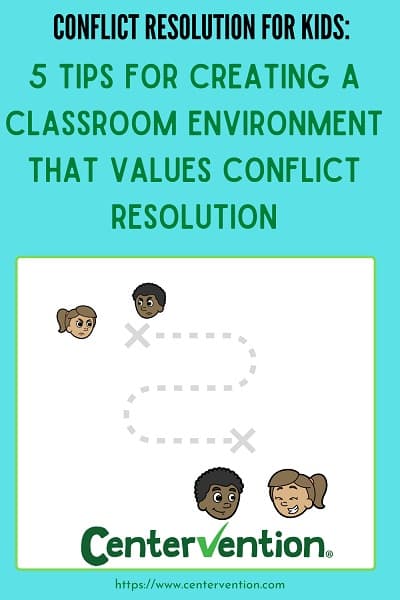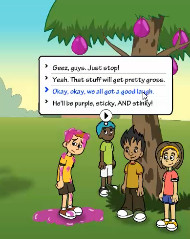Conflict resolution is an important skill for kids to master, but many students worry about saying or doing the wrong thing. They may worry about damaging new friendships, and as a result, they freeze up and feel stuck.
Fortunately, research suggests that while children may be hesitant to take action when conflict arises, they generally believe that caring for others is important.
With a little practice, students can develop the skills necessary to think carefully through challenges, and act in ways that are helpful in resolving conflicts and solving problems for themselves and others.
To help, we’ve created a conflict for kids lesson and rounded up some of our top tips so you can create a respectful classroom.
Recommended Grade Level: Elementary
SEL Skill(s): Communication, Cooperation, Empathy
Duration: 30 minutes
Materials: (Available when logged in to your Centervention Educator account)
- Conflict Resolution for Kids Poster
- Map a Solution Printable
Conflict Resolution for Kids Lesson
Lesson Prompt:
Gather students and ask the following questions, allowing time for a discussion for each:
- How does it feel when you disagree with a friend?
- What are some small/big conflicts you might have with a friend?
- What can you do to solve problems with a friend?
Show students the Conflict Resolution Poster. Choose 3-4 of the boxes and discuss why those strategies are important and helpful when working through a disagreement.
Next, point to the Map A Solution box and tell students that today they are going to learn a very special new way to help work through a problem with friends.
Say: When two people have a problem, it can feel a lot like they are on their own land, far away from their friend and their friend’s ideas. This map shows us what it might look like when our ideas are so far apart. What do you see in the middle?
(allow students to discuss Solution Island and the dotted paths to get there)
Say: When there’s a problem, it’s important to stay calm, recognize your feelings, and listen to what your friend is thinking and feeling, too.
Practice
Have two students come forward to help fill out a sample Map. Read the following scenario:
You two are working on a poster together and must come up with a name for your group. (Name Student 1) thinks you should be the Lightning Bolts, but (Name Student 2) thinks you should be the Hero Squad. (Student 1) gets angry and begins to raise their voice. (Student 2) grabs a marker and writes Hero Squad on the top of the poster without asking. You both realize that this is a problem and decide to map a solution to work through it together.
Guide students 1 & 2 through taking turns on each sentence starter as they listen to once another’s responses and complete the activity together. When they reach Solution Island, suggest that they use the back of the page to list new ideas if they’d like to sort through several solutions together before coming to an agreement.
This fun and reflective page is just one of many ways students can resolve conflicts independently while they develop healthy communication skills that will last a lifetime.
5 Tips to Teach Conflict Resolution for Kids
Tip #1: Develop Well-Rounded Friendships
One of the best parts of school is making friends, and supporting healthy relationships in the classroom is important from Day 1. When students explore the qualities of friendship, they understand the roles that listening, respect, and kindness play in making and being good friends. Help your students remember that, even during conflicts, friends and classmates have feelings and deserve to be treated well. Test out the Making and Keeping Friends and How to Be a Good Friend.
Tip #2: Build a Feelings Vocabulary
Perhaps the most helpful toolbox we can give students isn’t a pencil case– it’s a feelings vocabulary! Recognizing and naming feelings is a skill that must be taught, and the more students practice, the better equipped they are to manage their feelings and communicate. Expand students’ vocabulary with our List of 135 Emotions Words and be sure to check out our Song About Feelings For Kids.
Tip #3: Practice Emotion Regulation
Now that your students can name their feelings, it’s helpful to show them how to manage them. Regulating angry feelings is an important first step in successful communication and problem solving. Having an Anger Thermometer in the classroom helps students keep their actions under control as they sort through strong feelings. Similarly, teaching students to stay calm gives them room to breathe as they prepare to work through a challenge. Consider having students use our free, virtual Cool Down Corner where they can hit pause if they need a break.
Tip #4: Teach the Power of Words
Once they escape our lips, words can’t be taken back! An important skill for conflict resolution is to engage in disagreements and problem-solving with considerate and respectful dialogue that recognizes the value of perspective. We have several communication resources ready to go, and suggest the Think Before You Speak lesson, the I Statements Worksheet, and the Expressing Feelings Without Blaming Activity.
Tip #5: Sort Through Solutions or Agree to Disagree
Again, allowing students the time and space to come to a solution together is essential in developing their communication skills. Our Conflict Resolution Poster can offer options to students looking to come to an agreement. Still, sometimes a problem has no compromisable solution and when that happens, students can learn to Agree to Disagree. And if after things get heated an apology is in order, you can support genuine reconciliation with the lesson How to Apologize.
Lesson Extension Using Zoo U
With Centervention’s online SEL program, Zoo U, students have many opportunities to learn about conflict resolution.
For example in scene 4 of Empathy skill silo, Lester is misbehaving and drops a water balloon on a classmate, and several people laugh and make fun. Your students must identify the hurt students’ feelings and decide whether to join in and make fun of him or help him clean up.
If, you’d like to try Zoo U, or our other online SEL interventions, you can request a free trial here.

